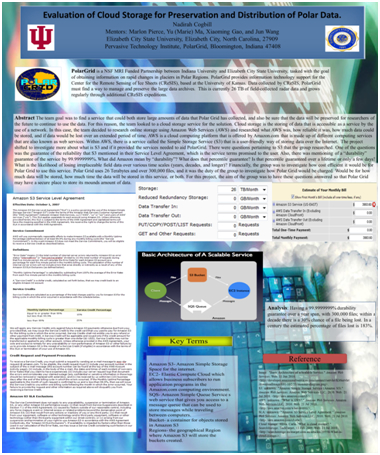|
 |
Research Experiences for Undergraduates Projects with
Community Grid Lab of Pervasive Technology Institute at Indiana University
STEM Scholars Institute, Summer 2010 |
 |
Project 5. Evaluation of Cloud Storage for Preservation and Distribution of Polar Data
Student: Nadirah Cogbill |
 |
 The team goal was to find a service that could both store large amounts of data that Polar Grid has collected, and also be sure that the data will be preserved for researchers of the future to continue to use the data. For this reason, the team looked to a cloud storage service for the solution. Cloud storage is the storing of data that is accessible as a service by the use of a network. In this case, the team decided to research online storage using Amazon Web Services (AWS) and researched what AWS was, how reliable it was, how much data could be stored, and if data would be lost over an extended period of time. The team goal was to find a service that could both store large amounts of data that Polar Grid has collected, and also be sure that the data will be preserved for researchers of the future to continue to use the data. For this reason, the team looked to a cloud storage service for the solution. Cloud storage is the storing of data that is accessible as a service by the use of a network. In this case, the team decided to research online storage using Amazon Web Services (AWS) and researched what AWS was, how reliable it was, how much data could be stored, and if data would be lost over an extended period of time.
AWS is a cloud computing platform that is offered by Amazon.com that is made up of different computing services that are also known as web services. Within AWS, there is a service called the Simple Storage Service (S3) that is a user-friendly way of storing data over the Internet. The project shifted to investigate more about what is S3 and if it provided the services needed to aid PolarGrid. There were questions pertaining to S3 that the group researched. One of the questions was the guarantee of the reliability that S3 mentioned in their Service Level Agreement, which is the service terms promised to the user. Also, there was mentioning of a “durability” guarantee of the service by 99.9999999%. What did Amazon mean by “durability”? What does that percentile guarantee? Is that percentile guaranteed over a lifetime or only a few days? What is the likelihood of losing irreplaceable field data over various time scales (years, decades, and longer)? Financially, the group was to investigate how cost efficient it would be for Polar Grid to use this service. Polar Grid uses 26 Terabytes and over 300,000 files, and it was the duty of the group to investigate how Polar Grid would be charged. Would be for how much data will be stored, how much time the data will be stored in this service, or both. For this project, the aim of the group was to have these questions answered so that Polar Grid may have a secure place to store its mounds amount of data. |
 |
|
 |
|
|
